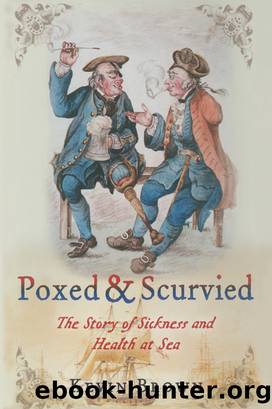Poxed & Scurvied: The Story of Sickness and Health at Sea by Kevin Brown

Author:Kevin Brown [Brown, Kevin]
Language: eng
Format: epub
ISBN: 9781473807662
Goodreads: 50932046
Publisher: Seaforth Publishing
Published: 2011-05-30T00:00:00+00:00
His successor on the Guildford Charles Linton considered the victuals to be âwithout exception of excellent qualityâ, and that the convictsâ quarters were well-ventilated, but was more critical of the ventilation of the hospital because it was below the forecastle. However, he considered exercise to be even more vital than ventilation, urging that âthe whole of the prisoners, except such as it may be found necessary to retain in irons as a punishment for crimes or refractory conduct committed on board, ought to be released from their fetters at a very early periodâ to get exercise and fresh air as much as possible, avoiding âthe intense heat of the dayâ.10 The success of the system of control of health and hygiene on convict ships is summed up by the comments of William McDowell, surgeon on the Lady East in 1825, that his charges âwere not sufficiently ill to be considered worthy of giving a minute description ofâ in his medical journal, âwith the exception of a considerable number of trifling cases such as constipation of their bowels or requiring cathartics and medicine occasionallyâ.11
The health and dietary systems used on convict ships offered a model for maintaining health on the government-assisted emigrant passages to Australia which started in 1831 and were funded by the sale of land in the colony to wealthy settlers. The ships on which these emigrants sailed were tightly regulated by the Colonial Land and Emigration Commission from 1840 and had to carry a qualified surgeon. At first naval surgeons were employed, many of them with experience on the convict ships although with little familiarity with pregnant mothers, children and babies. After 1840 the Emigration Commission preferred to employ civilian doctors. These doctors were to play an important role in maintaining the health of the emigrants, from the first medical inspection at the medical depot to screen out the unfit and sick to arrival in New South Wales. Not all of them were as concerned about their charges as they ought to have been. Samuel Archer, the 21-year-old surgeon on SS Great Britain in 1857, was more interested in natural history than in his passengers, and had to be recalled to the ship from the beach, where he was searching for shells during a stop at Mindelo, in order to treat a coaler who had fractured his skull when struck by a winch handle; he was perhaps as concerned that the previous day his white trousers had been soaked and caked with sand so that he âmuch resembled a bricklayerâ more than a surgeon.12 The surgeon was responsible not only for dispensing medicine and dealing with injuries but ensuring that âthe between decks were kept perfectly dry during the whole period of the voyageâ through daily dry scraping and sanding of the decks, and occasional fumigation âby pouring hot vinegar over the chloride of lime, which at all times had the effect of destroying any latent or unpleasant effluvia.â13
Many of the diseases with which the surgeon had to
Download
This site does not store any files on its server. We only index and link to content provided by other sites. Please contact the content providers to delete copyright contents if any and email us, we'll remove relevant links or contents immediately.
| Africa | Americas |
| Arctic & Antarctica | Asia |
| Australia & Oceania | Europe |
| Middle East | Russia |
| United States | World |
| Ancient Civilizations | Military |
| Historical Study & Educational Resources |
The Boundless Sea by David Abulafia(717)
Navigation by Jim Bennett(587)
The Last Voyage of the Andrea Doria by Greg King(457)
Three Sheets to the Wind by Cynthia Barrett(417)
Guide to the Crew of Titanic by Babler Gunter(305)
The Titanic Disaster by James W Bancroft(192)
A World of Empires: The Russian Voyage of the Frigate Pallada by Edyta M. Bojanowska(185)
Pirates: A New History, From Vikings to Somali Raiders by Peter Lehr(183)
Under Sail by Felix Riesenberg(166)
Why the Titanic was Doomed by Bryan Jackson(153)
Pirates Rogues of Monterey Bay by Todd Cook(130)
Poxed & Scurvied: The Story of Sickness and Health at Sea by Kevin Brown(128)
He Became a Salted Fish After Inheriting Millions of Secret Arts by Lips Are Lost 0(120)
The Combined Operation by Youds Peter(120)
SHIPWRECK by DAVE HORNER(116)
Sea Stories by Tom McCarthy(114)
The History of Navigation by Dag Pike(109)
The Wreck of the Neva by Cal McCarthy(102)
Pirates_A New History, From Vikings to Somali Raiders by Peter Lehr(88)
